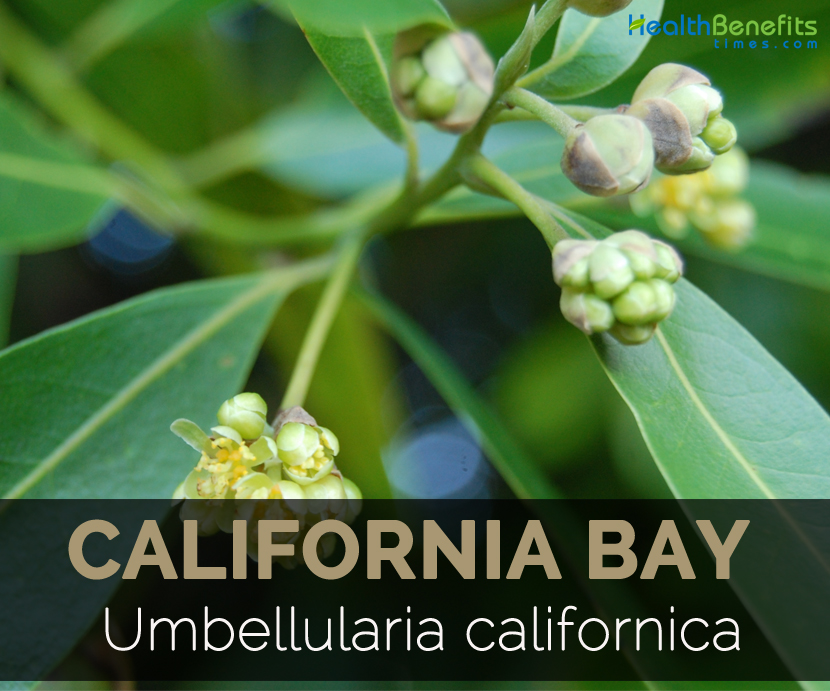| California bay Quick Facts | |
|---|---|
| Name: | California bay |
| Scientific Name: | Umbellularia californica |
| Origin | California and southern Oregon |
| Colors | Green to deep brown-purple |
| Shapes | Round, 1 to 2.5 cm in diameter |
This broadleaf evergreen tree is 3 to 45 meters high, loose foliage in shade and round gum drop habit when in open. Leaves are pungent with flavor resembling bay leaves i.e. stronger and are mistaken for bay laurel. The color of the dry wood ranges from blonde (maple) to brown (walnut). It is an excellent tonewood and sought by woodworkers and luthiers. Flowers are small; creamy that blooms in early spring. Fruit is elliptical to nearly round, greenish to purple and about 2 cm long that matures in late autumn.
It grows under various topographic and soil conditions with the availability of adequate moisture conditions. The aromatic plant has pungent odor that causes sneezing and headaches when the leaves are crushed or sniffed. As it contains umbellulone, a toxic mucous irritant and safrole, a known carcinogen.
Plant description
A perennial or evergreen shrub which is endemic to California and Southern Oregon. Trees have slender and erect branches and dense crown that is rounded to pyramidal shape. The height varies according to the conditions and grows from 3 to 45 meters tall. The smallest forms are found under dry conditions and reaches greatest size on deep alluvial soils near rivers. Bark is greenish to reddish brown, thin and smooth on young trees that begin to peel and shed as the trees starts to mature. Leaves are arranged alternately, oblong to lance shaped about 2.5 to 11 cm long and 1.5 to 3 cm wide. Leaves are thick, leathery, glossy and dark yellow to green. Leaves offer strong peppery menthol like odor when crushed which is the reason behind the name pepperwood kept by early European settlers. Flowers form in the clusters of 6 to 10. Fruits are round, olive like fruits, 1 to 2.5 cm in diameter that turns from green to deep brown-purple. The fruit has single large seed i.e. a white kernel encircled by light brown shell.
The plant grows in variety of soils derived from sedimentary, alluvial, volcanic or metamorphic parent materials. It prefers deep, well-drained and well-watered soils on alluvial benches, coastal slopes and valley bottoms.
Flowering & Fruiting
Flowers bloom on stems as young and fruiting usually occurs after 30 to 40 years. The buds form before flowering during the fall and flowers emerge before new leaves as early as November and continue through late spring. Flowers are pale yellow, about 0.6 inches in diameter that form in clusters and originates from leaf axils. Fruits are drupes that are usually round that ripens in the first autumn after flowering and the color changes from green to yellow, purple or brown when ripe.
Leaves
Leaves are aromatic when crushed. Leaves are simple, alternate, elliptical to lanceolate, dark green and shiny above and paler or smooth below with smooth margins. The leaves when crushed irritate eyes and nose.
Flowers
The blossoms are yellow to green, ½ inches wide that occur in fragrant clusters of 4 to 9 flowers in late winter. Fruits resemble an olive about 1 inch long containing a single and large seed.
Seed
Fruit has nutlike seeds usually 0.6 inches in diameter. Seedling and germination occur in autumn and soon after seedfall or in late winter and spring. Seeds should be planted immediately.
Traditional uses
- Infusion of leaves is used internally for treating intestinal cramps, neuralgia and gastro-enteritis.
- Women use the infusion to ease the pain of afterbirth.
- Use the infusion externally as the bath for treating rheumatism.
- Leaves decoction is used as sores wash and eliminate vermin from the head.
- Poultice of grounded seeds are used as sores treatment.
- Drink the leaf tea to treat colds, stomachaches, sore throats and clear mucus in the lungs.
- Roasted seeds when consumed with clover help to prevent bloating.
- Karok Indians apply the poultice of ground nuts to the skin for soothing sores.
- Inhale the crushed fresh leaves to relieve pain for headaches and nasal congestion.
- Apply the poultice to the head for treating headaches.
- Boil the leaves in water for treating colds and sinus infection.
- Use the poultice for treating toothache.
- Leaves poultice are a cure for shingles.
- Use the leaf oil for treating earaches and sores and prevent allergies in the spring. Also helpful for ulcers and colitis.
- Use the plant decoction as a wash for head lice.
- Leaves decoction is also used for menstrual cramps.
- Drink the infusion as a cure for headache and stomachache.
- Native Americans use the leaves to treat sinus congestion and headaches.
Culinary uses
- Cook the seeds or roast it.
- Ground the seeds to form powder and use it with cereal flours for making bread.
- Use the leaves as a condiment in cooked foods.
- Use it as a flavoring for stews and soups.
Precautions
- Foliage can cause skin irritation.
- Leaves oil can cause sneezing and headaches if inhaled.
- Leaves aroma causes headaches in some people.
- Nuts should be cooked before consumption.
Other facts
The wood is hard, fine grained and yellowish brown.
References:
https://www.itis.gov/servlet/SingleRpt/SingleRpt?search_topic=TSN&search_value=18208#null
https://pfaf.org/user/Plant.aspx?LatinName=Umbellularia+californica
https://plants.usda.gov/plantguide/pdf/cs_umca.pdf
https://ringtailcats.wordpress.com/2013/11/22/the-useful-california-bay-laurel-tree/
https://practicalplants.org/wiki/Umbellularia_californica
http://www.survivallandusa.com/Umbellularia-Californica-California-Bay-Laurel-Edible.html
https://nativefoodsnursery.com/all/california-bay-laurel/
https://www.savoryspiceshop.com/california-bay-leaves
https://oregonencyclopedia.org/articles/myrtlewood/#.XXIsjC4zb3g
https://davesgarden.com/guides/articles/view/4982
Comments
comments
